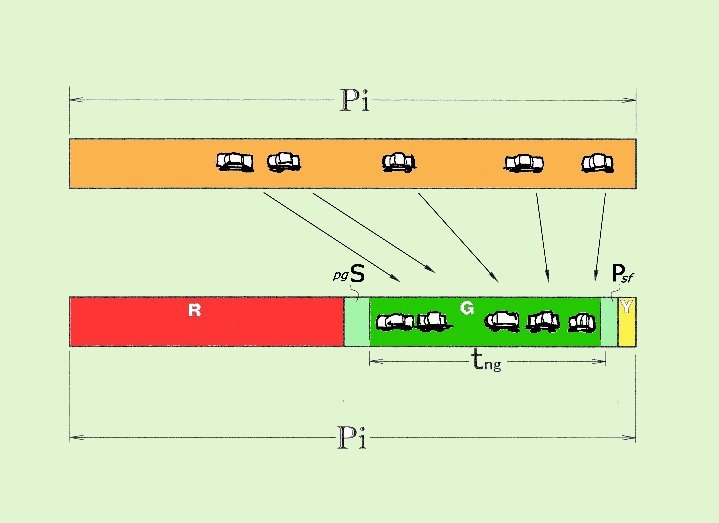

Go- Light
In the above "Consolidation" diagram, both patterns are traveling leftwards towards a traffic signal at the posted speed limit. The upper pattern represents the service cycle length of the
traffic signal before any traffic management occurs.
In this pattern, the vehicles are randomly distributed throughout the length (Pi) which matches the time of "Period of the Intersection". The lower pattern represents
the platoon of vehicles as it traverses through the signal. In the lower patrtern, all vehicles are consolidated to within a "net" Green segment (Tng), and therefore transit the traffic signal
without having to stop. Tng is part of the Green phase, less the safety buffers Pre Green Safety (pgS) and Safety Following (Psf). The pattern at the signal
also includes Red and Yellow phases. Considerable fuel savings, less pollution, less energy consumption are the result of motorists not
having to come to a complete stop.
Go-Light is an ongoing mobility deployment (all patent rights reserved) which saves energy through traffic management. FLOW stands for Fast Lane On Warning.
Under this paradigm, Green Phase Scheduling tells motorists how fast they should go in order to drive through a traffic signal while it is in green phase (without having to stop).
Go-Light G. L. O. S. A. functioning (all patent rights reserved) works 100% of the time in all directions!
Green Phase Scheduling readouts function as Actuated, Non-Actuated (autonimous), in options of On Board and Roadside Units (OBU; RSU). All Go-Light G. L. O. S. A. Non-Actuated Green Phase Scheduling hardware and software is compatible with NEMA TS1 controllers; all appropriate hardware and software for actuated schedulers is compitable with NEMA TS2, and NEMA TS1 controllers.
Non-Actuated functioning (patents pending) is mostly associated with emplaced type readout that is passed through RSU/RSE. Deployment of this version could be seen and acted upon as
soon as it is installed, and is readable by all vehicles that pass. Mobile Readout (US Patent 8,618,954) includes readout or output as an in-vehicle or on board unit (OBU). Deployed as original or special equipment (OEM; SEM), this readout type can be seen by anyone with either a built in or added-on/attatched readout device. Mobile Readout allows for higher HMI (Human Machine Interface) resolution, not to mention diverse graphics and audio. Mobile readouts can handle both Actuated and Non-Actuated (autonimous) scheduling.
As long as safety standards are met or exceeded, consistent scheduling readouts could come through a multitude of HMI types, and even simultaneous HMI types.
Actuated Green Phase Scheduling is where a system adapts based on sensors. Signal phases and timing (SPAT)
can be adjusted to further optimize mobility. For example, if a large platoon is detected from one set of directions (i.e. N-S),
and traffic is "lean" in the other set of directions (i.e. E - W), the green
phases can be expanded and contracted accordingly, thus further optimizing mobility. Sensory Adaptive can open/close
phases that apply to sitting traffic as well.
Safety
More fuel savings, less pollution, more mobility are all realized by deployment of Green Phase Scheduling. However, the premiere parameter
of a green phase scheduler is safety.
Safety factor 1. The approach to a signal is qualified out.
Safety Factor 2. The present condition of an approach to a signal is qualified out (best example is if vehicle headways are sensed/detected to be too close during any time of the approach to an otherwise qualified traffic signal).
While the settings vary between fuel consumption rate (i.e. environment, energy dependence) vs. headway (i.e.
safety following distances), there should be no reason why a lone vehicle or
small group approaching a signal in an otherwise empty region should have to make a complete stop at a traffic signal.
Benefits
Green Phase Scheduling offers dramatic incentive of mobility.
Environmentally speaking, this additional component of FLOW technology will reduce pollution output by
approximately 30% for each qualified run up; approximately 2.5% upon maximal national deployment; possibly as much as 10%. This savings will
happen regardless of whether the vehicles are diesel powered semis and buses or 100 mpg X-prize competitors
or coal-plant-fired electric cars.
Another benefit is reduction in cost for fuel not used, and lighter draw on foreign and domestic energy reserves.
E-mail at
info@Go-Light.net
Annotation
For a demonstrating animated map of how Green Phase Scheduling works, go here.
4-8-18
Green Phase Scheduling
